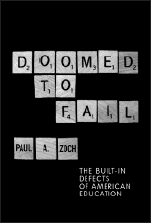 |
School Choice Tradeoffs: Liberty, Equity, and Diversity
by By R. Kenneth Godwin and Frank R. Kemerer
University of Texas Press, 2002, $29.95; 315 pages.
America lacks a theory that would explain how its current system of public schooling could function at an acceptable level. Such a theory would describe how the several components of schooling finances, administration, curriculum, teaching, and student characteristics–could come together in a way that yields educated children. This fundamental deficiency garners scant attention in much of the country because, in most suburbs and rural areas, parental guidance or social support enables students to reach adulthood passably educated. In the central cities it is a different story. There, at age 18–the age at which students are expected to exit the K-12 system–too many young people, particularly those of color, remain ill equipped for social life, parenting, employment, citizenship, and further education. There, the schools and the society have failed.
Plans for fixing the schools are regularly put forward. The one most often invoked, particularly by adults in the pay of the schools, is that adding funds would do the trick. This is not so much a theory–a theory would explain why more money would matter–as an assumption that the schools operate as machines: if they were fed sufficient numbers of dollars, they would yield good results. In this view, the level of spending matters because educators are deeply altruistic; devoting more money to hiring more such folks should help. However, this ignores the embarrassing reality that real per-pupil expenditures have more than tripled in the past four decades, without a corresponding rise in student achievement. Moreover, American government was founded on the expectation that, as James Madison put it, people are not “angels” and therefore need “precautions” to orient them toward socially productive behavior. The public school system lacks effective precautions.
Most academic research on education policy suffers from a similar implicit assumption: that the schools automatically use their resources well. The prevailing mode of research seeks to identify teaching or administrative practices that appear to have worked somewhere. Apparently efficacious practices are identified. This knowledge is then made available to educators in the expectation that they will snap up and implement the beneficial practices.
However, in general, the replication of effective practice has been spotty and disappointing. In fact, what researchers have most likely found (I fear without recognizing it) is not a set of approaches to education that will automatically be replicated, but rather that some visionary leaders–the John Deweys, David Weikerts, and Deborah Meiers of the world–can design and operate fine schools. How, then, can a free people induce its members–those who aren’t angels or geniuses–to accomplish public purposes?
In this vein, one turns hopefully to School Choice Tradeoffs. The book emerged from the authors’ study of choice programs in the schools of San Antonio, but it became an attempt at a sweeping synthesis of scholarly work on education policy, drawing on literature in philosophy, economics, political science, education, and law. There is much to admire here, but ultimately the book’s organizing idea–that education policymaking consists of confronting tradeoffs–diverts attention from the efficacy question.
The authors admirably illuminate the education policy debate by resorting to the ideas of liberal political philosophers from John Locke to Amy Gutmann. A central argument of the book is that liberal political philosophy has been altered significantly by the introduction of more statist continental thinking. Locke’s and John Stuart Mill’s arguments for individual autonomy retain power today, but in the 20th century Dewey and others, influenced by Hegel and other German thinkers, put forward an arresting claim: that the proper education of children requires a role for government so large that it would have shocked their liberal predecessors. Locke, deeply suspicious of the state, placed the responsibility for educating children with their parents. Mill thought similarly; indeed, he argued that poor parents should receive financial assistance from the government in order to afford the type of education they favor for their children.
Dewey, by contrast, saw the public schools as a benevolent force with a responsibility to erode the prejudices and parochialisms children acquire from their parents. Gutmann, a contemporary political philosopher, shares Dewey’s concern that parents, particularly religious ones, will indoctrinate children with irrationality and intolerance, making them ill suited for life in a democratic society. Thus arises the tradeoff that most concerns Godwin and Kemerer: individual autonomy and cultural pluralism versus social cohesion and a societal duty to rescue children from obscurantism. They subtly present and discuss this apparent conundrum.
Godwin and Kemerer next move to recount how courts have negotiated that tradeoff. They describe a period in the past century when individual and parental autonomy was usually upheld, followed (beginning with Brown v. Board of Education) by a period in which the courts, in the name of equal opportunity, considerably limited the ability of parents to control where and with whom their children would be educated. Very recently the Supreme Court has given parents more say in the education of their children. The authors’ analysis anticipates the Supreme Court’s decision in Zelman, released after this book’s publication, which found the Cleveland voucher program constitutional.
A strength–a formidable policy proposal–as well as the weakness of the book are found in the final chapter, in which the authors first discuss the contending political positions and concomitant tradeoffs regarding vouchers, then propose a voucher program they have planned in exceptional detail. The tradeoffs are variations on the fundamental fissure Godwin and Kemerer identify in liberal political philosophy: individual autonomy versus public accountability; religious freedom versus separation of church and state; cultural diversity versus coherent national values. They seek an “Archimedean point” at which these several considerations are in balance.
But the authors don’t seem to have decided whether they are analyzing conflicting interests or offering a compelling idea–a theory–which, if applied to schooling, would yield better-educated youngsters. Juggling tradeoffs is a description of normal politics, but it doesn’t consider the power of ideas. Appeasing opposing groups can leave unanswered the question of how to organize schooling so that children actually get educated.
In construing policymaking as the balancing of interests, Godwin and Kemerer eschew the power of an alternative understanding of policymaking, namely the design of institutions so that people are oriented to accomplish public purposes. In that understanding, a policy reflects a theory of how individuals and organizations act. Accomplishing education policy by mollifying factions is unlikely to raise student achievement. However, underlying the idea of vouchers are theories that competition properly structured can foster innovation and efficiency, and that choice can facilitate the formation and flourishing of nurturing communities. Perhaps those theories will ultimately be shown to be wrong. If so, voucher advocates will never prevail. They have other arguments on their side–vouchers would be fair because they would end double taxation, and vouchers would be American because they would respect individual autonomy. But those arguments will not persuade opponents, who will continue to see them as special pleading. A powerful theory has a chance of changing minds.
-John E. Brandl is a professor of public affairs at the University of Minnesota.




